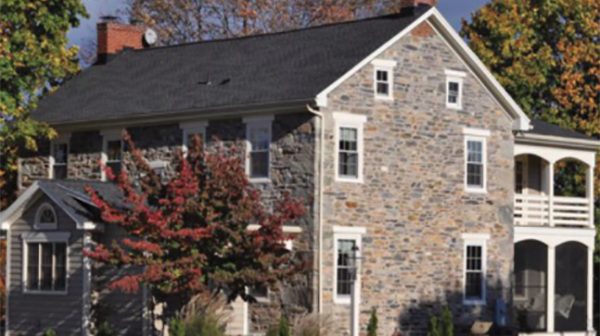Historic Home Renovations in Adams County
By Karen Hendricks
Home renos are all the rage. There are television shows, DIY blogs, YouTube channels, even experts such as “Property Brothers” Jonathan and Drew Scott reaching celebrity status thanks to America’s fascination with home renovations. Growth in the remodeling industry, measured in terms of consumer spending, has risen every single quarter since 2014. Projections for 2017 call for the home improvement and repair market to hit $327 billion, surpassing its previous inflation-adjusted peak from 2006. That’s according to the Leading Indicator of Remodeling Activity (LIRA) tracked by the Joint Center for Housing Studies of Harvard University.
Here in Adams County, many home renovations merge with residents’ deep appreciation of history. “In the Borough of Gettysburg we have Civil War era homes that line our streets. Further out in the country, there are beautiful farmscapes rich with all types of historic homes—not just Civil War homes but those going back to the 1700s,” says Anne Zabawa, president of the Historic Gettysburg Adams County (HGAC). Within Adams County, the real estate market always includes a variety
of historic properties, many builders are well-versed in renovating these historic gems, and a treasure trove of resources exists for homeowners.
A Labor of Love
“When you choose an old house, it’s not just the character, the space, the old hardwood floors—it’s about the lifestyle,” says Suzanne Christianson, agent and co-owner of Re/Max of Gettysburg. She knows first-hand—not just as a realtor but as a homeowner who continues to renovate her downtown, circa 1890s, Gettysburg property.
“There are all sorts of reasons people choose historic homes. They are very artful and unique—not cookie-cutter,” Christianson says. “They’re also nostalgic—people say old homes remind them of their grandparents or a house where they grew up. I feel like there’s a draw to the historic downtown because you’re able to walk downtown.”
Christianson says historic homes comprise a significant portion of home resales in Adams County, and the majority of them are well-built homes with “good bones.” In terms of advice, Christianson advises potential homeowners to “have realistic ideas and goals in terms of repairs and maintenance. You need to know what you’re getting into and be prepared. I look at buying an old house as a life investment.”
She cites common areas of concern in older homes: roof replacements, updated wiring, and new plumbing in bathrooms and the kitchen. “These things are not insurmountable, but they’re daunting to some people, so I always have that conversation with them. There’s a love of old homes for some people and not for others; nothing is wrong with either preference. I believe there’s a right house for everybody.”
And for her personally, she admits renovating her historic home is one of her weaknesses. “Some people travel, some like to shop…me, I always want to spend money on my house and make it something special. It’s definitely a labor of love.”
Cannonballs in the Fireplace
A recent, high-profile renovation project focused on the Civil War Trust’s restoration of General Lee’s Headquarters, by Mark Austin Building and C. E. Williams. “It was a dream come true” for Civil War buffs, says Josh Austin, office manager of Mark Austin Building and Home Remodeling. “Putting our hands to that project—we realized just how special that was. To be able to drive by 30 years from now and say we helped turn it from a hotel suite back to what it looked like in 1863…it’s amazing.”
In addition to commercial projects, Mark Austin Building is also accomplished in new home construction and home renovations—but all of their work stems from a desire to pursue unique, custom projects. That’s how Josh describes the founding of the company by his father Mark in 1985.
He says the Mark Austin crew is small, tight-knit, and talented—thriving on the challenges presented by historic homes, whether it’s an early 1900s craftsman-style home, an ornate Victorian from the 1800s, or an old log home. “It’s hard to call them challenges really, because those are the things we like to take on…matching trim work…replicating details and construction methods. We like restoring things—not just putting a Band-Aid on.”
When embarking upon renovations, Josh says it’s important to be prepared for a surprise or two. “We took down an old ceiling one time, and found that the old beams had been cut through to put plumbing in (through the years)—it was amazing it hadn’t collapsed.”
Josh’s expertise lies in estimating costs for homeowners. “A lot of historic home renovations tend to be labor intensive because of all the work involved,” he says. Finding the right materials can be like a treasure hunt. Austin says there are shops, similar to antique dealers, specializing in reclaimed building materials, scattered throughout the region. “If we can’t find what we need, we make it—that’s another reason we have our own sawmill.”
Austin says the company generally works on three or four historic home renovations a year. Many of them, like the recent renovation of a Springs Avenue, Gettysburg home, took a year to complete.
Homeowner Tamara Schwartz says she searched Gettysburg’s real estate market specifically for a historic home. In the fall of 2015, she became only the third owner of the brick home, built in 1908. “It had (original) wallpaper falling off the ceiling. Clearly not much had been done to it in at least 50 years,” Schwartz says. “But what was great about it…all the things you’d want in good shape were still in good shape—a solid foundation; wonderful windows, doors, and woodwork.”
Schwartz worked alongside the Austin crew nearly every workday; she personally removed all the old wallpaper. Four walls were demolished on the first floor—one of them replaced by columns, another replaced by bookcases, to create an open-concept layout inside the federal-style exterior.
Several treasures were found during the renovation: “When we started working on the gas lines, we discovered two cannonballs in the fireplace,” Schwartz recalls. After confirming with an expert that they were inert, she kept them as fun conversation pieces.
Overall, she says the project came together beautifully, thanks to the teamwork of everyone involved. “It feels
a little like living in a movie set now—it’s beautiful.”
A part of history
“I think the idea that you can take an older home and make it alive again…it’s gratifying and people take great pride in ownership,” says Zabawa. She says HGAC has long been recognized for its barn preservation efforts, but the nonprofit is building its reputation and resources for home renovation—mainly in three areas.
First, the organization offers a newly-compiled list of resources, called “Artisan Listing,” on their website. “It’s a list of experts in their fields pertaining to restoring a historic home or barn…(which) takes special skills,” Zabawa explains. Secondly, HGAC holds a series of monthly workshops geared toward historic home repairs, “Handy Homeowner Workshops,” from March to September.
HGAC’s Architectural Salvage Warehouse is a third resource—a gold mine of historic items donated by area homeowners, such as vintage shutters, windows, doors, hardware, and much more—currently including an old player piano. The warehouse is open by appointment by contacting HGAC; sales benefit the nonprofit.
HGAC recognizes several area homeowners annually via prestigious Home Restoration Awards. Zabawa says people who pursue historic home renovations usually have one essential driving force—vision: “They come into it with a vision…to keep part of history.”
Cherishing Their Historic Roots
All of the people interviewed for this article have a deep appreciation for historic homes, and many were cultivated back in their childhood memories.
“I grew up with the (home remodeling) company basically,” Josh Austin, 29, explains. “When I was a kid I was watching ‘New Yankee Workshop’ and ‘This Old House,’ going out on job sites, playing in the dirt or sweeping floors. I remember a project we did years ago when I was a kid—an old farmhouse in Cashtown. We did an addition with cedar siding, old wood floors, and we made cabinets out of old wood…it looked like it had been done years ago…I’m building my own home right now. It’s not really a job; it’s a lifestyle. I enjoy it, I’m having fun.”
“My family has always owned a historical farm in New Jersey,” says Anne Zabawa. “Growing up visiting this historical farm, I fell in love with what was happening on the farm.” But that wasn’t her childhood home—interestingly enough, she grew up in a very unique but historic setting. “My parents raised [me and my sister]on a historical yacht built in 1926,” Zabawa says. “It was very similar to a historical home in that it has beautiful woodwork, brass, all the qualities you’d see in a historical home. I loved the way it looked so much more than a modern home.”
Docked in the Navesink River in the town of Red Bank during the school year, her parents—both teachers—would spend summers sailing the yacht up the New England coastline for family vacations. “I lived on a boat my entire childhood through college,” says Zabawa.
Suzanne Christianson has a deep appreciation for the backstory of her historic home. So much so that she holds an annual reunion of sorts: Randy, the great-grandson of the man who built her home in the 1890s, visits once a year and brings his entire family. Christianson says, “We are all connected.”
“I grew up in an old farmhouse,” says Tamara Schwartz. “It was a New England farmhouse connected to the barn.” Those memories stuck with her and planted a seed for her future home. When she retired from the Air Force in 2013, she lived in Washington, D.C. and Boston. She spent the summer of 2015 living in Gettysburg, visiting her parents who had relocated here. “I would walk my dog up Springs Avenue and see this poor old home falling apart…never in a million years would I think I’d be buying it two years later,” she laughs. “Moving here from Boston…Gettysburg is a lot slower and now when I go into the cities, I look forward to coming home where it’s a lot more peaceful. There’s a lot to be said for small town living.”




